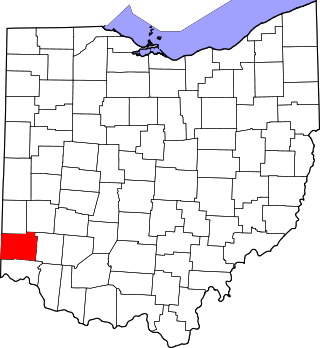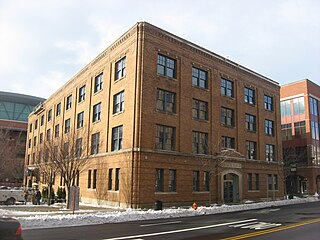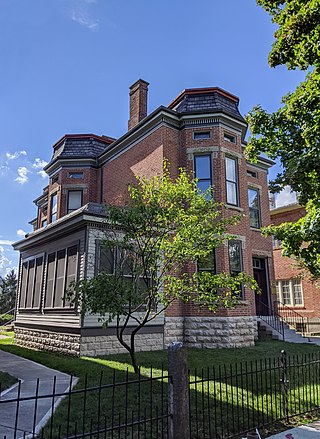
University, Hayes and Orton Halls are three historic buildings on the Oval at the Ohio State University in Columbus, Ohio. On July 16, 1970, they were added to the National Register of Historic Places. The original University Hall was demolished in 1971, and removed from the National Register that year.

The Henry Adams Building, also known as the Land and Loan Office Building, is a historic building in Algona, Iowa, United States. It was designed by Louis Sullivan in 1912.

This is a list of the National Register of Historic Places listings in Butler County, Ohio.

Saint Paul's Episcopal Church is a historic building in Columbus, Ohio.

The Fountain Hotel is a historic former hotel in downtown St. Marys, Ohio, United States. Built in 1889 in a mixture of the Queen Anne and Victorian architectural styles, the hotel building sits in the 100 block of West Spring Street.

The Columbia Larrimer Building is a historic building in Downtown Columbus, Ohio. It was listed on the National Register of Historic Places in 1983. The building is significant for its storefront design and craftsmanship, along with the front interior installed by the Bott Brothers when they moved their bar there in 1905. The building was home to the Clock Restaurant in the mid-to-late 1900s, and currently Elevator Brewery & Draught Haus.

The Ohio Moline Plow Building is a historic building in the Arena District in Downtown Columbus, Ohio. It was listed on the National Register of Historic Places in 1999. The building was built in 1913 as an office, warehouse, and sales space for the Ohio Moline Plow Company, part of the Moline Plow Company based in Illinois. It is located in a former warehouse district, which once held numerous buildings of similar size, scale, and materials. In the late 20th century, most of the buildings were demolished. The building is also significant for its design integrity and materials, with original patterned brickwork and stone trim, and glass and wood office partitioning.

The Buckeye Building, also known as the Buckeye State Building and Loan Company Building, is a historic building in Downtown Columbus, Ohio. The 16-story building was built from 1926 to 1927. It was the headquarters for the Buckeye State Building and Loan Company, and after 1949 for the Buckeye Federal Savings and Loan Association. It was listed on the National Register of Historic Places in 2004. The building was converted into a hotel, opening as a Marriott Residence Inn in 2008.

The Citizens Building is a historic building in Downtown Columbus, Ohio. It was listed on the Columbus Register of Historic Properties in 2013, and was listed as part of the High and Gay Streets Historic District, on the National Register of Historic Places, in 2014.

The Lubal Manufacturing & Distributing Company buildings are a set of two industrial buildings in the Franklinton neighborhood of Columbus, Ohio. The site was listed on the Columbus Register of Historic Properties in 2015 and the National Register of Historic Places in 2016. The buildings include 373 West Rich Street, built c. 1900, and 375 West Rich Street, built c. 1911. With much of the original materials intact, the buildings are few remaining that demonstrate Franklinton's early industrial and commercial history.

The First Congregational Church is a Congregational church located in Columbus, Ohio, United States. The building was listed on the Columbus Register of Historic Properties in 1982 and the National Register of Historic Places in 2021.

The Greater Columbus Arts Council (GCAC) is an arts organization in Columbus, Ohio. The council funds artists and organizations in Central Ohio, and hosts the annual Columbus Arts Festival.

The Columbus Landmarks Foundation, known as Columbus Landmarks, is a nonprofit historic preservation organization in Columbus, Ohio. The foundation is best-known for its list of endangered sites in the city and its annual design award, given to buildings, landscapes, and other sites created or renovated in Columbus. It was established in 1977 as a project of the Junior League of Columbus, Ohio, following the demolition of the city's historic Union Station. It is headquartered at 57 Jefferson Avenue, a contributing structure in the Jefferson Avenue Historic District in Downtown Columbus.

The United States Carriage Company is a historic building in Downtown Columbus, Ohio. It was listed on the Columbus Register of Historic Properties in 2014 and the National Register of Historic Places in 2015.

The Jeffrey Manufacturing Company Office Building is a historic building in the Italian Village neighborhood of Columbus, Ohio. The building, originally used for the Jeffrey Manufacturing Company, was listed on the National Register of Historic Places in 2001 and the Columbus Register of Historic Properties in 2015.

The Julian and Kokenge Company building, now known as the Julian, is a historic building in the River South District of Downtown Columbus, Ohio. It was listed on the National Register of Historic Places in 2013.

Tosheff's Restaurant and Hotel is a historic building in the Reeb-Hosack neighborhood of Columbus, Ohio. It was built in 1920 and was listed on the National Register of Historic Places in 2001. The restaurant and hotel are one of few remainders of the historic Steelton industrial area, and closely connected to the eastern European neighborhood there. The industrial district was centered on Parsons Avenue, and relied upon the Buckeye Steel Castings Company, American Rolling Mill Company, the Chase Foundry and Manufacturing Company, the Federal Glass Company, and the Seagraves firetruck manufacturing plant.

The Peruna Drug Manufacturing Company Building was a historic building in Downtown Columbus, Ohio. It was built c. 1902 and was listed on the National Register of Historic Places in March 1973. The building was demolished in November 1973.

The First Avenue School is a former public school building in the Harrison West neighborhood of Columbus, Ohio. It was listed on the Columbus Register of Historic Properties in 1983, and was listed as part of the Near Northside Historic District, on the National Register of Historic Places, in 1980. The building is one of the oldest in the neighborhood, built in 1874. It is also one of the oldest remaining school buildings in Columbus, built at the same time as the Second Avenue School and Stewart Alternative Elementary, also still extant. In 1984, Wood Development remodeled the building into the First Avenue Office Center at a cost of $1.2 million.




















